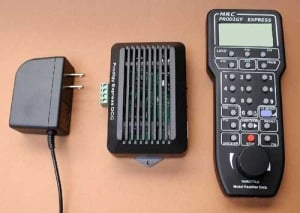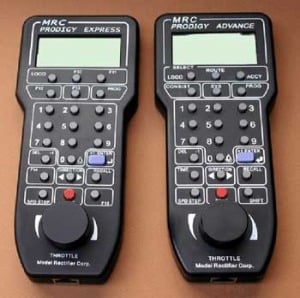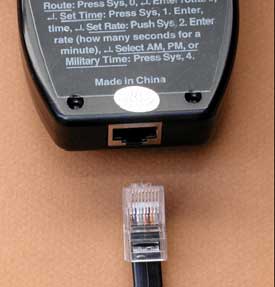MRC Prodigy Express Review
by Don Fiehmann
How Times have Changed
When DCC systems were first marketed I was a bit reluctant to change over from dc. My main reason for holding off was the high price of the systems that were available. Then systems cost over $500 and decoders were relatively expensive compared to today’s prices. Competition and advances in technology have brought down the cost of getting started in DCC. Now you can buy a DCC system for not much more than a good power pack. Not only have prices fallen but the number features available have increased. I feel the DCC market has started to mature and is becoming more accepted. MRC (Model Rectifier Corporation) has responded to this with a line of popular priced DCC products. MRC has recently added a new line diesel and steam sound decoders to their DCC products along with DCC systems.
Enter the Prodigy Express
The MRC line of DCC systems is called “Prodigy”. The most recent addition to this line of DCC systems is the “Prodigy Express”. This new system is a trimmed down version of the Prodigy Advance DCC system. The Prodigy Express is aimed at the low end of the DCC market. The Prodigy Express comes complete with a handheld cab, command station/booster, and ac adapter (transformer). The system is made in China.
The Prodigy Express System
The ac adapter is a small universal switching power supply that will work on input voltages from 100 to 240 volts and has an output of 15 volts at 1.6 amps. The input voltage range should allow it to work almost anywhere in the world. The output plugs into the command station/booster. There is no power switch on the transformer or the command station/booster.
The command station is combined with a booster with a rated output of 15 volts at 1.6 amps. The rating of 1.6 amps should be ample to power at least a few HO locomotives and more in smaller scales. For larger scales MRC has boosters available that will work with the Prodigy Express command station. The command station also has a plug for the cab connection. There is power enough for 6 cabs. Extension panels are available with or without added power for adding more cabs. This system will support up to 20 cabs. Either the Prodigy Express or Prodigy Advance cabs can be used. It does support two digit addressing of 1 to 127 and four digit of 1 to 9999 plus consisting. The Prodigy Express does not support the use of analog or non-decoder equipped locomotives. There are outputs for the main track and for the program track. The software in the Prodigy Express command station /booster is very similar to the Prodigy Advance software. They operate the same with only a few minor changes.
The Prodigy Express Cab is the same size as the Prodigy Advance Cab. The difference is the Prodigy Express has fewer features than the advance cab with the same number of keys. The advance cab uses a shift key so F0 to F9 become F10 to F19. The express cab adds keys for F10 to F15 in place of the features removed from the advance cab. The added features of the advance cab can be used with the Prodigy Express system by using a Prodigy Advance Cab. Most of the basic command can be executed with the express cab. The advance cabs add system setup commands, fast clock, program track read back, universal (old-style) consisting, routes and accessory decoders setup. If you can’t find the instruction manual there is a list of instructions on the back of the cab for quick references.
The cabs have the ability to recall DCC addresses. Up to 25 address can be used but only 5 will be retained by the cab when power is turned off. The cabs are connected with cables using telephone style connectors.,The Prodigy systems use an 8 pin connector. Most DCC systems use the 6 or 4 pin connectors. There are cab extension panels with the 8 pin connectors available from MRC.
Testing
To test the Prodigy Express I connected it to my HO layout. I started by running two QSI sound equipped engines , a standard Athearn F7 and a SoundTraxx LC decoder equipped locomotive. No problem with high startup current. I even consisted the four and ran them with no problems. All engines ran OK and all the functions controlled OK.
Prodigy Express and Prodigy Advance Cabs. They look
the same but the Advance cab has more features.
The only problem is the F2 key is used for the horn or whistle and blows when pressed and stop when released. On one of the engines I had a strobe light programed for F2. The strobe would only work with the key pressed. I fixed it by mapping the strobe to operate on either F2 or F3. All of the other Function key toggle on and off for each time they are pressed.
I ran a power test on the output using an RRampMeter. With no current the voltage was 14.5 Volts. At 1 amp the voltage dropped to 13.6 volts. At 1.6 amps, the rated output, the voltage was 13.1. I ran the output at 1.64 amps for over 10 minutes without a shutdown. At slightly higher current the output did shutdown. When the output was shorted and the short corrected the power came back on from the booster, but the cab display showed “SvdA”. To clear the display I had to unplug the cab and plug it back in or turn the power off and back on. There is no power switch so you either have to unplug the transformer or use a power strip with a switch. The Prodigy Advance system would return to normal after a short. Is this a bug or feature?
You should avoid setting anything on the top of the command station as there are air vents on the top and blocking the air flow could cause it to overheat.
I have a 2 by 4 foot N scale portable layout that I use for DCC demos and testing. This small layout has a loop of track and a few switches. Two of the switches have NCE Snap -Its for control of a track that cuts across the loop making a reversing section. There are three power districts using #912 automotive lamps for short circuit protection. The reverse loop uses the MRC #AD520 reverse loop adapter. With the low power from the Prodigy Express the one amp 912 lamp would light on a short without shutting down the booster. Most of the electronic circuit breakers like the PowerShields trip at a higher current than the rating of the Prodigy Express. The same is true with many of the reversing loop adapters. The MRC #AD520 is rated at 2 amps and worked OK. Commonly used lamps for short circuit protection like the 1141 and 1156 both will draw too much current and trip the booster, but the 912 at one amp works OK.
Cab uses 8 pin phone type connections.
I have three DCC equipped N scale diesel locomotives that are used with the portable layout. I forgot the address of the Concor PA1. I used the program track and the read-back function of the Prodigy Advance cab to read the address There was no problem running the three. I got two running as a consist around the loop while switching with the third locomotive. To operate the two Snap-Its I to used the Prodigy Advance cab.
Conclusion
The Prodigy Express is a low cost system best used for a small layout using with maybe one or two operators. Z to On3 locomotives can be powered from the booster. The Prodigy Express cab is more like an operators cab than a system cab like the Prodigy Advance cab. The Prodigy Express Cab can not address the standard accessory address range. The exception is the MRC #AD360 accessory decoder that uses mobile (locomotive) addresses 1 to 127. If you need to either control DCC switches or need the read-back capability adding a Prodigy Advance cab to the Prodigy Express system puts you close to the cost of the Prodigy Advance system. Plus the Prodigy Advance gives you higher power. It would be no surprise to see the Prodigy Express cab offered as a separate item that could be used to increase the number of operators on either the Advance or Express system. Making cab cables may be a problem because the 8 pin connectors are not as available as the 4 and 6 pin connectors. The list price of the Prodigy Express system is $169.98.



